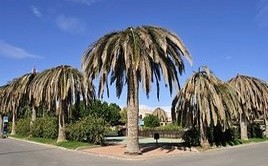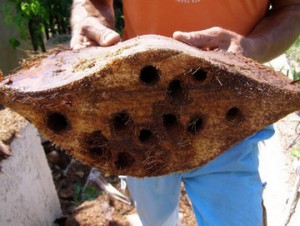Originally from tropical Asia, the Red Palm Weevil reached Spain in the mid-1990 and from there; it has invaded other parts of the world and has caused tremendous damage and loss of thousands of palm trees and at great expense.
Red Palm Weevils are large insects and adults may even reach a length of 5cm. The appearance of the red palm weevil is unmistakable in that it has a large mouth and is generally bright red in color with black markings. Since adults have diurnal habits they are easily detectable. Larvae live within palms and can reach a large size. Although other beetle species may also appear, specifically the chafer or otherwise known as the black Potosia Opaca, they can easily be recognized because their larva have six small legs whereas the red palm weevil has no legs. It is important to make the distinction between these insects because the chafer feeds on rotting materials and will not damage healthy palms.
 As long as sufficient live plant material is present on a palm, the weevils will continue to feed on a plant and lay their eggs on it, so that infestations within single palms can continue to grow for several generations until they reach hundreds of beetles. Once palms can no longer offer enough food, adults will disperse to find new plants to infect. Although Red Palm Weevils are active all year round, adults are most active and numerous during the summer months. They have a considerable ability to disperse and are capable of flying more than three kilometers a day.
As long as sufficient live plant material is present on a palm, the weevils will continue to feed on a plant and lay their eggs on it, so that infestations within single palms can continue to grow for several generations until they reach hundreds of beetles. Once palms can no longer offer enough food, adults will disperse to find new plants to infect. Although Red Palm Weevils are active all year round, adults are most active and numerous during the summer months. They have a considerable ability to disperse and are capable of flying more than three kilometers a day.
Mature palms are most susceptible, making the damage incurred more costly. The Red Palm Weevil causes a high incidence of mortality in all species that it infests and has caused the death of thousands of palms over the last few years. Common targets are palms that have been badly pruned or which have been weakened due to transplantation. Since adults are most active during the summer months, this period presents the highest probability of new infections.
 Diagnosing infections with Red Palm Weevils is not easy. During the initial stages of infection, the weevil occurs at low densities and causes limited damage, which may in addition be masked by the state of the injured or sickly palms that they prefer to attack. However, symptoms become obvious once palms become infested. The time it takes for the symptoms to become apparent, as well as the symptoms themselves, depends on factors such as the point of entry of weevils, the level of infestation and the health of the palm itself, with unhealthy palms showing symptoms more quickly.
Diagnosing infections with Red Palm Weevils is not easy. During the initial stages of infection, the weevil occurs at low densities and causes limited damage, which may in addition be masked by the state of the injured or sickly palms that they prefer to attack. However, symptoms become obvious once palms become infested. The time it takes for the symptoms to become apparent, as well as the symptoms themselves, depends on factors such as the point of entry of weevils, the level of infestation and the health of the palm itself, with unhealthy palms showing symptoms more quickly.
When the weevil enters the palm by the crown, it causes the greatest damage since this will stop the growth of new fronds and will ultimately kill the palm. Initial symptoms in such cases are new leaves in the centre of the crown that show signs of having been eaten, or that are leaning or appear weak. At a more advanced stage, the centre of the crown will collapse entirely. When palms are attacked through damaged tissue away from the crown, the damage is usually less severe. Symptoms in such cases will include mature fronds losing their normal orientation, giving the palms a disordered and asymmetrical look. When infected fronds are pulled off, tunnels produced by weevils will be visible, along with detritus produced by larvae. Other symptoms include (i) a smell of rotting and fermenting plant material emitting from affected parts of the trees, and (ii) the large exit holes of adult weevils. The larvae and pupal cases of these beetles can also be found in affected plants.
 Reaching a decision on whether to treat or remove a palm will depend on a number of factors, such as (i) the age of the palm in question, (ii) the monetary value of the palm, (iii) the palm’s importance to the landscape, and (iv) the probability of infection of nearby palms. Decisions should be made quickly to ensure effective containment of infestations and palms that are not treated should be removed. Use of the insecticide ‘Imidacloprid’ is recommended from June to September, when the weevils are most active and abundant.
Reaching a decision on whether to treat or remove a palm will depend on a number of factors, such as (i) the age of the palm in question, (ii) the monetary value of the palm, (iii) the palm’s importance to the landscape, and (iv) the probability of infection of nearby palms. Decisions should be made quickly to ensure effective containment of infestations and palms that are not treated should be removed. Use of the insecticide ‘Imidacloprid’ is recommended from June to September, when the weevils are most active and abundant.
Populations of Red Palm Weevils can also be controlled with pheromone traps. These traps should be placed in areas where weevils are known to occur, but away from palms. They are highly effective when the density of weevils is low and when used in conjunction with pesticides and nematodes. They will not, however, eradicate the problem on their own, but when densities are higher, they will still cause reductions in weevil populations and lower infestations on palms. Baiting traps with attractants such as dates or sugarcane will result in a significantly higher incidence of capture. The pheromone employed is an aggregation pheromone produced by males that will attract both sexes, although a higher ratio of females is normally captured than males. Insecticide should be placed in these traps to kill trapped weevils. Studies have shown that traps that are placed on the ground are more successful than those that are suspended, and that red or camouflaged traps attract more beetles than white ones.
 The advice given by experts is not to use pheromone traps in an area unless the presence of the Red Palm Weevil has been proven, since they attract weevils from a considerable distance and could result in the infection of sites that are still weevil-free.
The advice given by experts is not to use pheromone traps in an area unless the presence of the Red Palm Weevil has been proven, since they attract weevils from a considerable distance and could result in the infection of sites that are still weevil-free.
The remains of infested palms should be buried immediately after removal. Infected plant material should be covered in insecticide and placed in polythene bags. The pesticide ‘Clorpirifos’ could be used for this purpose. Care should be taken when applying the pesticide and should only be applied by properly trained personnel wearing protective gear. Burning the remains is not effective due to the high level of moisture present in rotting palms. Disposal should take place close to the area of infection, as transportation of infected plant material into as-yet uninfected areas may result in the inadvertent dispersal of adult weevils emerging from the felled palm.

